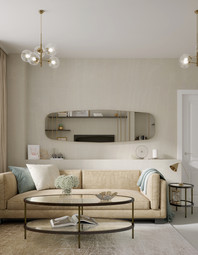Reasons why 3D visualisations are becoming standard in the design industry
- Anna K
- Oct 26, 2020
- 4 min read

In the design world – as in many other industries - clients’ preferences and expectations are constantly evolving, thus reflecting how quickly the industry is changing. To stay competitive and relevant you have to adapt to these changes and make sure your business is at the top of its game.
3D rendering is no longer reserved for big design companies only. The technology required in the process is becoming more affordable and many design professionals are more open to using new tools in order to deliver the best service to their clients.
Let’s talk about it in more details and find out why 3D rendering is becoming a standard service in the design industry.
Clients respond better when they can see real-life images
Interior designers carry significant responsibility not just for the visual impression and the comfort but also for the functionality and the safety of their clients’ living or working space. On one hand, 3D rendering offers clients an opportunity to see how the interior will look and feel before they decide to go ahead. On the other hand, based on this visualisation, the designer can ensure that the planned interior fulfils all aesthetic and technical requirements.
Compared to other visualisation methods, 3D rendering offers superior features. Your clients can experience the final look of the interior and they can even explore textures and colours. As a designer, you can also opt to display the ambient looks with different lighting effects, like natural vs artificial or day vs night.
You can impress your clients
Prior to assigning their project to a design partner, clients often approach more than one interior designer to get some visual feedback and a quote.
At this point, you have a better chance to impress your clients and win their business if you use 3D rendering to show your vision of their interior in the best possible light. Clients are very likely to welcome this, especially if you include this service as a part of your standard package.
It allows you to improve your own marketing credentials
In addition to sharing 3D visualisations with your prospects and clients you can include these in your own portfolio. You can upload the material on your website or publish all or part of it on social media channels.
You can be competitive
Throughout the design industry 3D rendering is becoming more popular and in some international markets it is actually the norm already. For anyone wanting to stay competitive in this fast developing environment, it is paramount to embrace new technologies, including 3D rendering.
It increases convenience for all
Time has become a precious commodity for most people – designers and clients alike. Visiting an office across town just to look at sketches is not the most efficient use of anyone’s time. In many situations, it’s not even possible because of the location. Most recently, in the face of the new Covid-19 reality, we all had to learn how to deal with restricted movements. 3D rendering allows you to continue working efficiently and conveniently. You can email the images, send them via messaging apps, publish them on social media, share them on a Zoom call or upload them on a website.
The cost is lower than you think
Only very few independent designers, business startups or SMEs will be able to cover the cost of getting started with 3D rendering in-house. Overall, the hardware, software and the training required still represent a considerable financial burden for most. However, there is an easy and cost-efficient alternative: outsourcing. Rather than shelving the idea all together, you can always engage a talented freelancer to enhance your projects with 3D visualisation work.
It saves time during the initial project phase
Every interior design project should go through an initial approval phase. Once you finalised the initial design you should seek your client’s approval before you continue working. In the last few years, many designers have found 3D rendering to be more efficient and less dependent on resources at the same time.
Being able to use 3D interior renderings in approval process makes it faster and easier. Should any changes be agreed with your client, you can address these quickly and efficiently. Overall, one of the biggest benefits of 3D rendering is the amount of time you can save during the development phase.
Clients are more tech-savvy
A large percentage of today’s clients are Millennials, members of a generation, which has grown up with technology. The level of proficiency and confidence when using technology is rather high - not just among design professionals but clients as well. The majority of clients now appreciates the involvement of the latest technologies in their projects. 3D rendered interior designs are just the ticket.
The above list of reasons for 3D rendering becoming an industry standard is not exhaustive. We put it together as an attempt to highlight some of the areas where both sides, interior design professionals and their clients, benefit from this amazing technology.
Please click here to get in touch with us.













Comments